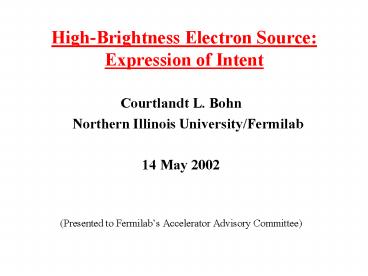High-Brightness Electron Source: Expression of Intent - PowerPoint PPT Presentation
1 / 14
Title:
High-Brightness Electron Source: Expression of Intent
Description:
... to FNAL, ANL, LBNL, DOE, and NSF asking for encouragement ... Will submit university proposals to DOE & NSF which will increase university contributions. ... – PowerPoint PPT presentation
Number of Views:154
Avg rating:3.0/5.0
Title: High-Brightness Electron Source: Expression of Intent
1
High-Brightness Electron Source Expression of
Intent
- Courtlandt L. Bohn
- Northern Illinois University/Fermilab
- 14 May 2002
- (Presented to Fermilabs Accelerator Advisory
Committee)
2
Photoinjector Three (Pi3)
- A collaboration for the construction and
operation of a high-brightness electron beam at
Fermilab. - Advanced beam research and machine development.
- The collaboration presently includes seven
universities and three laboratories. - An Expression of Intent submitted 02/11/02 to
FNAL, ANL, LBNL, DOE, and NSF asking for
encouragement to begin a design report.
3
Motivation
- Fundamental beam and accelerator physics
- Wakefield laser acceleration.
- Bunch Compression.
- Flat Polarized Beams.
- Emittance Reduction.
- All of which will promotes growth and innovation
through university training of accelerator
physicists. - Support for the new generation of linear
colliders, FELs, and synchrotron radiation
sources (1 micron emittance and 270 micron
pulses) - Demonstrate that injector specifications can be
met. - Platform to study generation of required beams.
- Develop expertise and infrastructure for LC
efforts. - Utilizes superconducting RF cavities and will
foster Midwest and national development of the
technology.
4
Notional Layout of Photoinjector (as envisioned
by DESY cf. Conceptual Design of the XFEL
Photoinjector by M. Ferrario, K. Floettmann, B.
Grigoryan, T. Limberg, Ph. Piot)
Output Beam for FEL LC bunch charge is 3.2 nC
Energy 140 MeV ? 300 MeV
5
Major Components
- Drive laser (provides a flexible pulse structure
and train) with a CsTe photocathode (high QE). - Emittance compensating solenoids.
- A DESY donated 1.3 GHz, 8 cavity cryomodule
(immediate acceleration reduces emittance growth
due to space charge). - 3rd Harmonic superconducting RF section to
correct non-linearities in longitudinal phase
space. - Four-dipole compression stage.
- Diagnostic matching section.
- A domestically developed cryomodule.
6
Laser and Gun Requirements(based on FEL
requirements)
7
Simulation Results Transverse Parameters
8
Simulation Results Longitudinal Parameters
9
Longitudinal Phase Space Before and After
3rd-Harmonic Section
10
Phase Space After Bunch Compressor
AFTER
BEFORE
11
Collaboration/Contributions
- Modeled on particle physics collaborations.
- Envision the laboratories (Fermilab, Argonne,
LBNL, DESY) taking responsibility for larger
projects. - Infrastructure (Fermilab, ANL for chemistry)
- RF Gun (ANL), High repetition RF Gun (LBNL)
- Cryomodules (DESY, Pi3)
- 3rd Harmonic (Fermilab/LBNL)
- Compressor (Fermilab/ANL)
- While the universities (Chicago, Michigan, NIU,
Northwestern, Pennsylvania, Rochester, UCLA ) . - Contribute personnel (e.g., students!) to
laboratory-based projects - Take responsibility for smaller projects
- Simulations
- Laser
- Diagnostics
12
Scope Support
- Scope
- Schedule Approximately a 5 year construction
project. - Cost A ball-park figure of 30M including
MS, labor - Collaboration working on (phased) schedule and
cost - Funding prospects
- Laboratory contributions will be crucial.
- Requested significant DoEd funding (3M ? 2 years
6M) - Expect continued state support through Illinois
Consortium of Accelerator Research (ICAR). Total
grant now 2.5M/yr would submit additional
request. - Will submit university proposals to DOE NSF
which will increase university contributions.
13
A Staged Scenario
- Some observations
- Optimistic about DoEd support
- Multi-laboratory interest
- Funding agencies cautious, partially associated
with LC technology choice, partially with
resource limitations - Suggests an intermediate path compatible with LC
choice - Reduced initial cost
- Permits pursuit of beam physics
- Does not foreclose on future options.
- 1st Stage
- Upgraded FNPL at new Fermilab site
- Footprint infrastructure consistent with
eventual expansion to 1 mm and 300 MeV - Current gun, additional Tesla cavities or
cryomodule, 3rd Harmonic cavity, new compressor - 2nd Stage (a year or two later)
- Proposal for 1 mm and 300 MeV will benefit from
additional time and experience - Axially symmetric gun and second cryomodule
14
Conclusions
- Pi3 will greatly strengthen HEP and the
laboratories - A small scale program already proven successful.
- A collaborative model to promote accelerator
physics (will be opened to additional
institutions). - Strengthens accelerator physics infrastructure.
- Supports development of new technologies and
machines.
The collaboration has requested laboratory
assistance to develop a design report by the end
of August.































